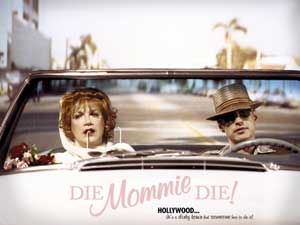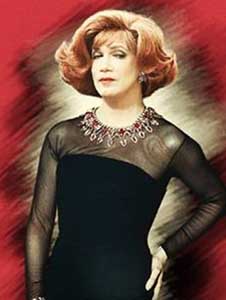-
- Lesbian couple wins custody battle
- S.D. high school approves gay/straight support group
- Pa. Senate hopeful embraces same-sex marriage
- Assembly fails to override veto of marriage bill
- Mass. gay-marriage ban unconstitutional
- Bishop defends distribution of pamphlet condemning same-sex marriage
- Philadelphia wants you
- Student evicted for alleged ‘gay-bashing’ quits school
- National News Briefs
- World News Briefs
Arts & Entertainment
To ‘Die’ for
Published Thursday, 20-Nov-2003 in issue 830
Die, Mommie, Die!, the movie version of Charles Busch’s stage play, is a zany, kitschy, suggestive homage to Dead Ringer and other films of that ilk, with Busch starring as semi-washed up singer-with-a-dark-secret Angela Arden. Theater director Mark Rucker, who had run the Chicago Marathon the day before our interview, makes his cinematic directorial debut with this colorful comic feature. Talented, handsome and charming actor Jason Priestley (yes, his eyes really are that blue) stars alongside Busch as her young male love Tony Parker, who also romances Angela’s daughter Edith (Natasha Lyonne) and is seduced by her son Lance (Stark Sands), who also has a secret of his own.
Gay and Lesbian Times: Had either of you seen the play staged before doing the movie?
Mark Rucker: I did. I’d seen lots of Charles’ work in the past. I was in L.A. when he was doing the production there. I went to see it specifically with the possibility that it may be a film project.
GLT: With that in mind, what was it about the play that made you want to make it into a movie?
MR: First of all, it was the idea of taking Charles’ work and making a movie out of it. I’d been interested in something like that for years, but never thought that it could come to pass. It’s partly because his work is so filmic. It’s based on Hollywood cinema, all of it, even though it’s theater.
GLT: What was it about the role of Tony Parker that called your name?
Jason Priestley: I think that’s pretty obvious (laughs). The script for Die, Mommie Die! was such an inventive and original piece of material. For me, it was something that I sparked to right away. The role of Tony was so much fun. He’s such an unbelievable cad and he paid off so well in the end. Really a lot of fun to portray. I look for roles that are different and this certainly was that.
GLT: Was it a daunting task to make ‘Die, Mommie, Die!’ your directorial debut?
MR: I come from the theater, so it was just about making the transition from theater to film, and it really wasn’t that hard.
GLT: In watching the movie, with the acid trip and the black and white musical flashbacks, I had to wonder how they were able to make that come across on stage.
MR: Well, they didn’t. There was an LSD sequence, but it was all basically a monologue and there were some lighting effects.
GLT: Are there advantages and disadvantages to sustaining that level of high camp throughout the movie?
MR: One of the things that we had to do was constantly keep track of how far over the top we were going. In some cases, even though we were moving rather quickly, we were trying to get some takes that were a little bit more and some that were a little bit less. In general, I feel like the actors basically took it seriously, so that they weren’t winking (at the audience). Jason’s performance is as dry as it could possibly be, as far as I’m concerned.
JP: (Laughs)
MR: He never makes a false move. He never turns and winks at the audience. He just goes for it from the first moment to the end and that’s why it’s so good and it doesn’t wear out its welcome and you’re constantly intrigued by it. That’s what I hoped for and what I think happens in most of the movie.
GLT: Jason, did you feel like you were holding yourself in a little bit?
JP: It was one of those things — me being a director as well — I, of course, was watching what Mark was doing…
MR: Oh, come on. He was helping me out (laughs). I learned a great lesson from Jason. I would say cut, and he would keep going for about three seconds longer. And when I was editing, it was like, “God bless you.” Because he knew to keep it going just a little bit longer. It was a great lesson.
JP: (Laughs) I didn’t know that. That’s good. Right on. Mark did a phenomenal job of keeping all of us actors at the same level — the level that he was looking for and the level that the movie was playing on was obviously a little over the top for all the actors. He did an amazing job of keeping us at the same level so that the audience really goes along with it.
GLT: Not only did you have the writer, Charles Busch, there, you also have him in the movie as the lead character.
MR: But the writer was way too busy to be thinking about the rest of the movie. He had a huge performance to think about; and also, constant makeup. It was eighteen days of watching for a five o’clock shadow. When you’re doing it on the Avid playback and you’re looking for the shadow, but you don’t know until you actually see the film what’s going to be captured — that was sort of terrifying.
GLT: So, you never got a look from Charles, as if to say you didn’t say a line the right way?
JP: No, never.
MR: He was thrilled by the rest of the actors in the movie, and so excited to have this one (indicating Jason) there.
JP: Charles is obviously a very talented man and he obviously can keep everything compartmentalized. The writing of it is over here and the performing over there.
MR: Another thing that I think happens is that the script’s almost ready when you get to filming and there’s a lot of craziness that goes on. We really tried to have it as finished as possible before we started because there just wasn’t time. And also so that Charles would not have to focus on being the screenwriter so much.
GLT: In watching the movie I was thinking about how much the costumes were an integral part of ‘Far From Heaven’ and the same holds true for ‘Die Mommie Die!’ Was it fun to dress up in those period outfits and walk around in them?
JP: Absolutely. I hadn’t worn those Sansabelt cigarette pants since I shot Calendar Girl in `92. For me, it was fun. That sixties wardrobe is so freaky and styley and not a natural fiber to be found anywhere.
GLT: There is also a man on “man” screen kiss with Charles (as Angela). Is there something that Stanislavski would have taught his actors to prepare for this?
MR: Jason was just, “Let’s go, let’s go.” He basically had to do most of that stuff in one day. We didn’t realize it when we scheduled it. Now you kiss Charles, now you get in the shed with Stark (Sands, who plays Angela’s gay son Lance). I’m sure by the end of the day he wanted to shoot pool and have a beer.
GLT: You are known for taking on roles in films with strong appeal to queer viewers such as ‘Love and Death on Long Island,’ ‘Common Ground’ and now ‘Die, Mommie Die!’ How does it feel to have a visible gay following?
JP: I think it’s fantastic. As an actor you want to explore and try different things. It’s all part and parcel of the same thing. I come from Canada, the land of the same-sex marriage — it’s all good where I come from. I’m happy with all of it.
GLT: You have also developed a following among filmgoers for your work in independent films. Why are you pursuing those roles?
JP: Oftentimes the studio system doesn’t know what to do with actors who’ve been on very successful television shows (such as “Beverly Hills 90210”) and thankfully, I have found a home in independent film. I find independent film to be so much more interesting and I have the opportunity to work with talented and wonderful people, such as Mr. Rucker here. And Charles Busch and Natasha Lyonne and John Hurt. I’ve had some of my greatest experiences working on these interesting independent movies and I hope that continues.
|
|
Copyright © 2003-2025 Uptown Publications





